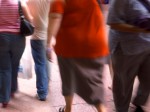 Men’s health in New Zealand has deteriorated at a faster rate than women’s over the past 12 years. The results of nutrition and adult health surveys between 1997 and 2012 give us some clues as to why this may be so.
Men’s health in New Zealand has deteriorated at a faster rate than women’s over the past 12 years. The results of nutrition and adult health surveys between 1997 and 2012 give us some clues as to why this may be so.
Overweight or obese
Although men do have a faster metabolic rate than women (at rest and during activity) it appears that ‘getting into shape’ is harder for them with 40% of men compared with 30% of women being classified as overweight in the last National Nutrition Survey (2011/12).
While men (at 28%) are now as obese as women (29%), it is concerning that they are becoming obese at a faster rate. In a The National Nutrition Survey of 1997 17% of men and 20.6% of women were obese.
Waist to hip ratio
When fat accumulates around the abdomen there is an increased risk of diseases of the heart, pancreas, gall bladder and liver (as well as a decline in prostrate and testicular health in men). This abdominal (visceral) fat is determined by the ratio of waist to hip measurement which for good health should not exceed 0.9 for men and 0.8 for women.
The 1997 Survey found that this risk factor increased with age with 70% of men in the 44-64 year age group over the limit compared to 50% in women in middle age. While recent stats on abdominal fat are unavailable the longer term effects on men’s health are now apparent.
The complications of obesity
As weight is gained there is a corresponding increase in a variety of diseases and deterioration in health.
Heart Disease
In the 2011/12 survey ischemic heart disease was affecting 7% of men compared to 4% of women and cholesterol levels were elevated (and medicated) in 11.5% of men compared to 9% of women.
Stroke
Blood pressure (medicated) levels have dropped for men from 22% in 1997 to 14% 2011/12 (v’s women for the same period 18% to 17%) and yet men in 2011/12 are still having more strokes (1.9%) than women (1.7%).
Diabetes
As weight increases abdominally the pancreas is less able to secrete sufficient insulin, of good strength to handle elevated blood sugar levels and diabetes results. This now affects 6% of men and 5% of women in New Zealand up from 2-4% in adults in 1997.
Fewer visits to the doctor
In the 2011/12 adult health survey it was found that men have fewer visits to their doctor (74%) compared to women (82%) so this may contribute to men’s deteriorating health not being recognized as quickly as it should.
Physical activity
Exercise is an important way to control body weight and men appear to be more physically active (57%) compared to women (50%) in 2011/12. It is recommended that all adult New Zealanders aim to increase their activity to between 30-60 minutes each day.
Dietary factors
So if men are more active than women in 2011/12 why are they becoming more overweight?
A closer look at the differences in the diet of men and women in 2008/9 may offer some clues as to the trends we are seeing now.
Men ate more saturated fat
The accumulation of saturated fat in the arteries increases the risk of obesity, diabetes and heart disease. This is how men have been eating more of this type of fat than women.
- They removed the fat from meat less often (56.5%) than women (67.4%).
- They ate slightly more butter and margarine (3.7%) than women (3.5%).
- Had more hot chips (10.9%) than women (4.3%).
- Ate more fried takeaway meals 3 or more times/week (7.9%) than women (3.8%).
- Had more red meat (95.6%) than women (93.5%)
- Consumed more processed meat (90%) such as sausages and luncheon compared to women (85.4%).
- Ate more battered seafood’s 1-2/week (19.8%) than women (11.7%).
- Drank more full cream milk (48.6%) compared to women (38.4%).
- Men also ate fewer low-fat meals (32.8%) than women (43.4%).
- Canned fish which is a source of healthier omega 3 polyunsaturated fats were eaten less often by men 3-4 times/week (4.7%) than women 6.4%.
Men ate more salt
An excess of dietary sodium can be associated with hypertension and stroke. In New Zealand men in 2008/9 were choosing to eat lower salt or salt reduced foods (12.3%) less regularly than women (16.2%).While their (medicated) blood pressure levels have improved in the 2011/12 survey, stroke remains a risk factor for them.
Men drank more calories
Good hydration is important to prevent bladder and bowel problems, as well as prostate cancer and erectile dysfunction. Water and low-fat milk are recommended.
Fruit juice and carbonated drinks are a major source of sugar and energy which can contribute to weight gain and the development of diabetes.
In 2008/9 men drank more juice 30.9% than they did in 1997 (25%). Women’s intake over this period also increased to (34.5%) compared to 1997 (27%).
Men’s’ intake of carbonated drinks for this ten-year period remained the same at 30% while for women their levels were a lot lower 17.4% in 2008/9 (27% in 1997).
It will be interesting to see the impact of energy drinks on these statistics when they are released later in 2013. For more information on the consumption of carbonated drinks read Lea’s article “what are our children drinking?”.
Men consumed more alcohol than women
Whether caught up in business meetings; socializing with friends at the rugby or enjoying a beer over the barbeque, there are plenty of opportunities for men and women to drink.
Unfortunately alcohol has a major effect on abdominal fat and obesity.
Men consumed less alcohol in 2011/12 (18.4g/day) than in 1997 (20g/day). However this was still considerably more than for women over the same period 9.9g/day in 2011/12( up from 8g/day in 1997).
In 2008/9 men preferred to drink more beer (56%) than women (11%) and also drank less wine (24%) than women (66%).
There were some improvements in men’s health 2011/12
- Men are eating 3 vegetables per day more often (64%) compared to 1997 (59.3%)
- Men have a better intake of dietary fiber than women because although they may not eat as many breakfast cereals or as much fruit they do consume more bread.
- Smoking levels have declined.
Motivation is the key
It may take a colleagues heart attack; a new girl friend on the scene; the desire to run the coast to coast or to gain selection to play golden oldies in order for men to change their diet and exercise routines.
For practical ideas read Lea’s articles:
Simple ways to improve men’s health
Tips to get off the couch
Have you lost your mojo lately?
or contact us for a personal assessment and help.





























































Leave a Reply